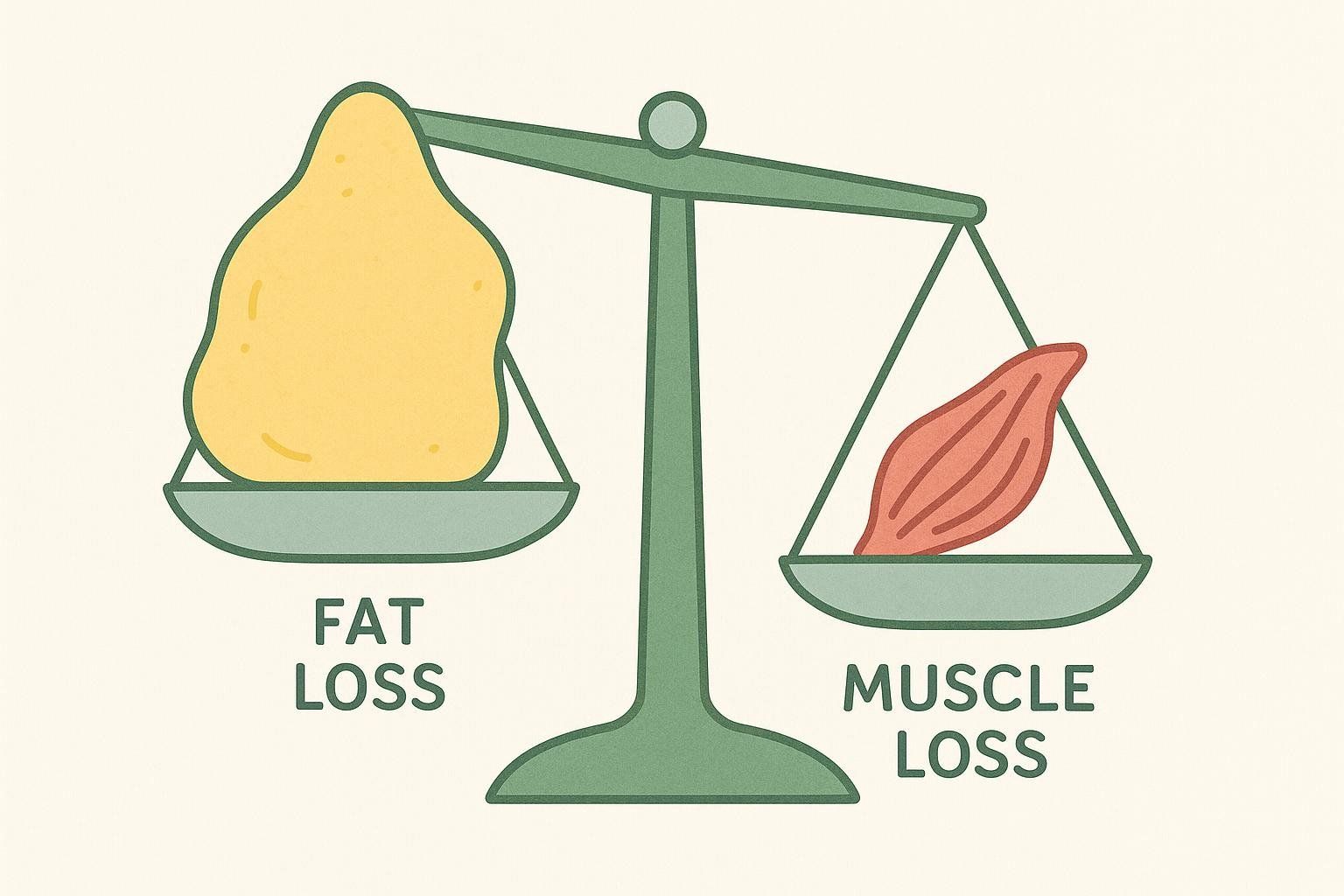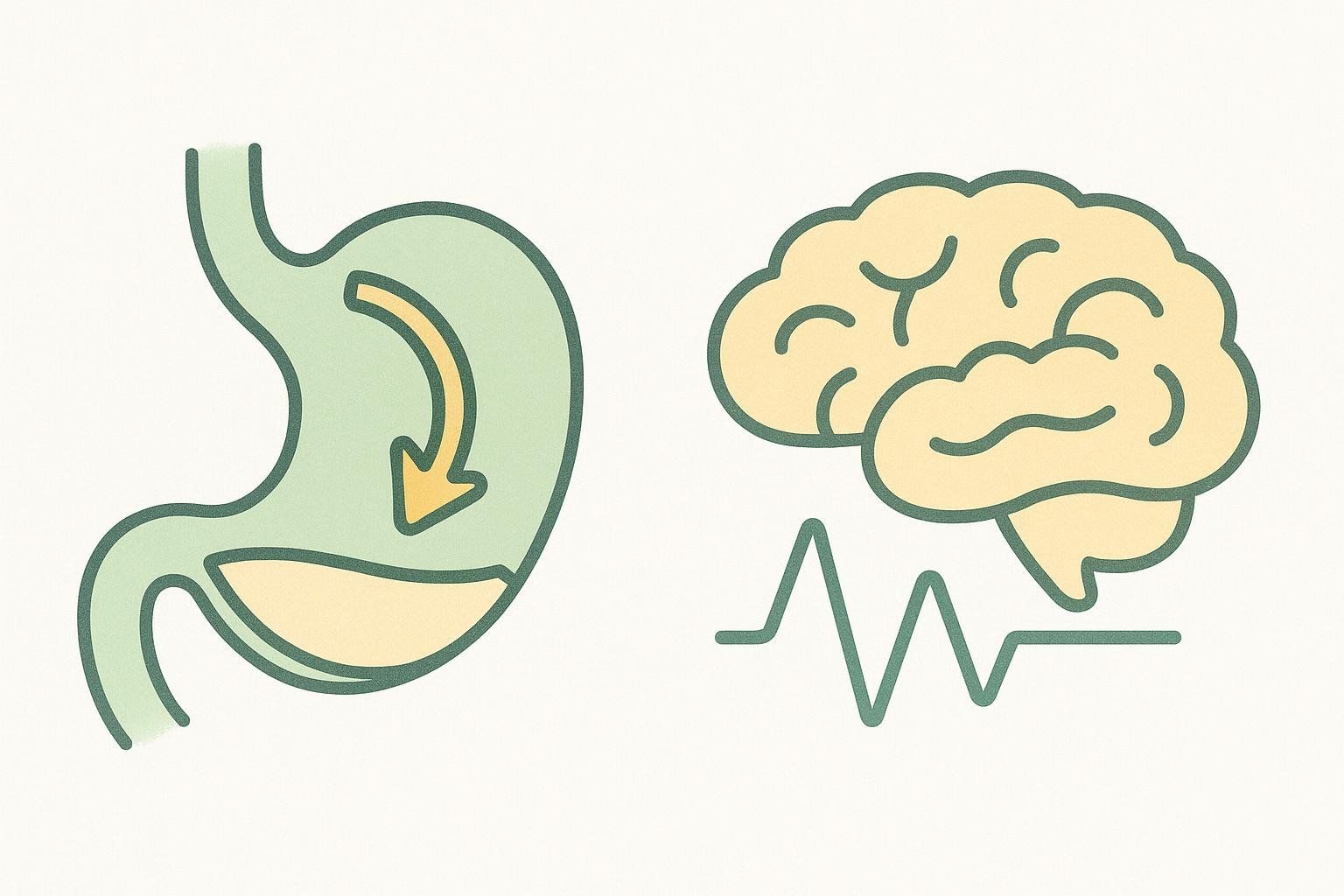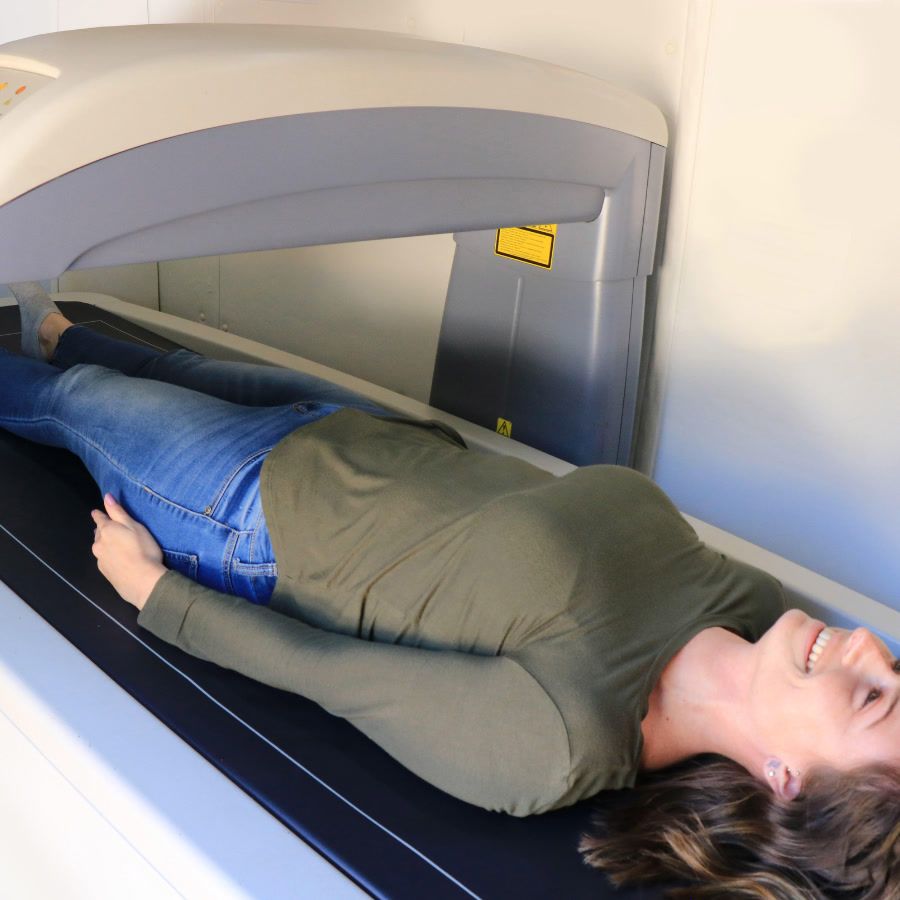Ozempic Muscle Loss: How to Prevent Lean Mass Reduction

Ozempic Muscle Loss: Preventing Lean Mass Reduction During Rapid Weight Loss
Ozempic (semaglutide) is an injectable GLP-1 receptor agonist with proven benefits for blood-sugar control and—when prescribed off-label—remarkable fat loss. However, a common concern for new users is the potential for Ozempic muscle loss. Up to 40 percent of the weight lost on the medication may come from lean tissue rather than fat (Wilding et al., 2021).
This article explains why this occurs and outlines strategies to mitigate it.
Ozempic Muscle Loss: Clarifying Skeletal vs. Cardiac Muscle Concerns
Some headlines warn that GLP-1 drugs could shrink cardiac (heart) muscle. Those findings are preliminary, seen only in animal or cell studies, and heart-muscle size can’t be tracked with DEXA (UofL Health, 2024).
The clinically relevant concern for Ozempic muscle loss is skeletal muscle—the tissue that lets you lift groceries, burn calories, and shows up on a BodySpec scan. That’s the focus of this guide.
Why Rapid Weight Loss Costs You Muscle on Ozempic
Ozempic suppresses appetite and slows digestion, creating a powerful calorie deficit. Without enough dietary protein and resistance-training stimulus, the body taps muscle tissue for energy.
Key trials such as STEP 1 and SUSTAIN 8 report that roughly 39–40 % of total weight loss on semaglutide comes from lean mass (Wilding et al., 2021; McCrimmon et al., 2020). A 2024 systematic review echoed these findings, noting lean-mass reductions of up to 40 % across semaglutide studies (Ramos et al., 2024).

If muscle loss occurs due to the rapid weight loss often facilitated by Ozempic, it can lead to serious consequences:
- Lower resting metabolic rate (RMR), so you burn fewer calories at rest and future fat loss can stall.
- Reduced functional strength, making everyday tasks—like climbing stairs or hoisting luggage—harder.
- Higher risk of weight regain; the greater the Ozempic muscle loss, the faster fat tends to creep back.
- Increased long-term danger of sarcopenia, a clinical decline in muscle mass and function.
Understanding Ozempic Muscle Loss Mechanisms
Ozempic mimics the gut hormone GLP-1, producing three calorie-slashing effects (StatPearls, 2024; Ozempic Prescribing Information, 2023):

- Slower gastric emptying prolongs fullness.
- Appetite-signal dampening in the brain reduces hunger.
- Improved blood-sugar control—more insulin, less glucagon—steadies energy swings and curbs cravings.
These actions are highly effective for fat loss, but they also widen the energy gap between calories consumed and calories burned. Without adequate protein or resistance exercise, the body pulls amino acids from muscle to cover that shortfall.
What the Research Says About Ozempic and Lean Mass
| Study | Population & Duration | Avg. Total Weight Lost | Lean Mass Change |
|---|---|---|---|
| STEP 1 DEXA substudy (Wilding et al., 2021) | 95 adults with obesity on injectable semaglutide, 68 weeks | ≈ 14.8 kg (−15 %) | ≈ 39 % of loss was lean mass |
| Oral semaglutide prospective study (Cantone et al., 2023) | 32 adults with type 2 diabetes on oral semaglutide, 26 weeks | −4.3 kg (median) | Lean mass maintained (no significant change) |
While Ozempic is injectable, insights from oral semaglutide studies are still relevant because both forms activate the same GLP-1 receptor—though the administration route may influence the magnitude of lean-mass change.
Emerging Muscle-Preservation Research
A 2024 pre-clinical mouse study from the Salk Institute—reported by Medical News Today, 2024—found that boosting the protein BCL6 helped maintain muscle mass during GLP-1-driven weight loss. Another investigational drug, bimagrumab, is being studied for adding lean mass while enhancing fat loss alongside GLP-1 agonists (Drugs.com, 2024). Neither therapy is clinic-ready yet, but the pipeline is encouraging.
5 Strategies to Prevent Ozempic Muscle Loss
1. Dial In Your Protein Intake

Aim for 1.4–2.0 g of protein per kilogram of body weight per day to preserve muscle during calorie restriction (Kerksick et al., 2017).
For those chasing maximal strength or hypertrophy, meta-analyses suggest additional benefits from protein supplements taper off around 1.6 g/kg/day, while intakes up to 2.2 g/kg/day remain within safe and effective bounds (Morton et al., 2018).
Below are two user-friendly ways to find your daily target:
A. Use Your DEXA Report (fastest & most precise)
- Locate your lean body mass (LBM) in kilograms on the BodySpec report.
- Then, multiply your LBM (in kg) by 1.8–2.0 to determine your daily protein target in grams.
• Example: 55 kg LBM × 1.9 g/kg ≈ 105 g protein/day.
Evidence shows 1.8–2.0 g/kg of LBM maintains muscle during energy deficits (Helms et al., 2014; Longland et al., 2016).
B. Waiting on your DEXA scan? Estimate With Body-Weight Math
- Calculate Ideal Body Weight (IBW) with Devine’s formula—Men: IBW (kg) = 50 + 2.3 × (height in inches − 60); Women: IBW (kg) = 45.5 + 2.3 × (height in inches − 60).
- Check weight status: Is your actual weight ≥ 120 % of your calculated IBW?
- Convert your scale weight to kilograms. If you weigh in pounds, divide by 2.205.
- Choose the right base weight:
• If your actual weight is ≥ 120 % of your IBW, first calculate your Adjusted Body Weight (ABW) using the formula: ABW = IBW + 0.25 × (actual weight − IBW).
• Otherwise, use actual body weight. - Set your daily protein target by multiplying that base weight (in kg) by 1.4–2.0.
Quick rule of thumb: This yields roughly 100–140 g per day for adults weighing 150–220 lb (68–100 kg)—a common range among people starting Ozempic.
For more detail on how different protein sources support muscle, see our guide on protein sources and muscle growth.
2. Strength-Train 2–4 Times Per Week

Resistance exercise triggers muscle-building pathways and curbs breakdown. A 2022 meta-analysis of 114 trials found that structured lifting maintained—or even added—lean mass during calorie deficits (Buckley et al., 2022). New to weights? Check out BodySpec’s beginner strength program.
3. Keep Weight Loss to 0.5–1 kg (1–2 lb) Per Week
Moderate loss rates protect muscle better than crash diets. If your scale nosedives faster, talk with your prescriber about dosage or nutrition tweaks (Mayo Clinic, 2022).
4. Prioritize Sleep & Recovery

Seven to nine hours of sleep lowers cortisol and boosts growth hormone—both muscle-friendly (Sleep Foundation, 2023). Use off-days for walking or mobility work.
5. Track Body Composition, Not Just Scale Weight
A bathroom scale can’t reveal whether pounds lost are fat or muscle. Regular DEXA scans quantify fat mass, lean mass, and visceral fat, letting you adjust protein or training before significant muscle loss develops. Harvard Health notes visceral fat’s strong tie to cardiometabolic risk—even at “normal” weights (Harvard Health, 2021).
How BodySpec DEXA Scans Help You Manage Ozempic Muscle Loss
BodySpec’s mobile clinics make it simple to keep tabs on lean mass:
- 10-minute, low-radiation scan (about the exposure of eating four bananas).
- Detailed report on total and appendicular lean mass, plus visceral fat.
- Progress graphs that flag early signs of muscle loss while taking Ozempic so you can discuss adjustments with your healthcare provider.
How Often Should You Scan?
Most clients scan monthly or quarterly. An 8–12-week cadence aligns with common 4-week Ozempic dose-escalation reviews, giving two to three medication checkpoints between scans. Interventions as short as eight weeks have produced detectable DEXA changes in lean mass (Buckley et al., 2022), so a two-month follow-up scan is advisable.
For more detail, learn about how GLP-1s like Ozempic affect lean mass and how to measure muscle changes during Ozempic treatment.
Ready to track your muscle health on Ozempic? Book a DEXA scan and leave with actionable data in under 20 minutes.
FAQs About Ozempic Muscle Loss
How soon after starting Ozempic can muscle loss show up on a DEXA scan?
Lean-mass changes have been detected in research studies over eight-week periods, so scheduling your first follow-up scan around the two-month mark is advisable (Buckley et al., 2022).
Can high-protein diets harm my kidneys while I’m on Ozempic?
A 12-month crossover trial in resistance-trained men found no adverse kidney effects at intakes up to 3.3 g/kg/day (Antonio et al., 2016). However, individuals taking Ozempic—especially those with underlying health conditions—should discuss significant increases in protein intake with their healthcare provider to ensure it’s appropriate for their specific situation, regardless of known pre-existing kidney disease.
Will creatine or BCAAs protect my muscles on Ozempic?
A 2023 review of 10 trials showed creatine adds small but measurable muscle-size gains when paired with lifting, whereas evidence for standalone BCAA supplements remains inconsistent (Silva et al., 2023).
Is it possible to gain muscle while losing fat on Ozempic?
Yes—especially for beginners. A 2024 narrative review by Atherton et al. concluded that resistance-training programs lasting more than 10 weeks added roughly 3 kg of lean mass on average—even when participants were in a calorie deficit or using GLP-1 drugs like semaglutide (Atherton et al., 2024).
Key Takeaways
- Prioritize adequate protein intake—aim for 1.4–2.0 g/kg of body weight.
- Keep a consistent resistance-training regimen (2–4 sessions per week).
- Get 7–9 hours of quality sleep and allow for proper recovery.
- Schedule regular BodySpec DEXA scans to monitor fat and lean mass changes.
Following these steps will help ensure the weight you lose with Ozempic comes primarily from fat—not muscle.
This article is for informational purposes only and is not a substitute for professional medical advice. Always consult your healthcare provider before altering medication, diet, or exercise.
Schedule your DEXA scan today and make your Ozempic journey data-driven.


